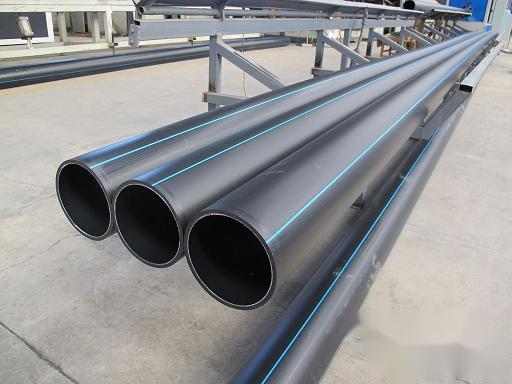90PE Pipe, PE Water Supply Pipe, Polyethylene Pipeline
Luoyang Guorun Pipe Industry specializes in supplying HDPE mining pipes, PE sand suction pipelines, PE water supply pipes, and polyethylene pipelines.
The welding of PE sand suction pipelines and butt welding of PE pipes provide high reliability and a wide range of diameters and pressure processes: the ends of the heated pipes are joined using a tool called "contact pressure" under defined temperature conditions. The ends are quickly brought into contact and held under pressure during the cooling process.
HDPE mining pipes are made from polyethylene plastic, which is a type of plastic that includes items like plastic bags and cling film. HDPE is a high crystallinity, non-polar thermoplastic resin. The appearance of raw HDPE is milky white, and it is somewhat translucent in thin sections. PE has excellent resistance to most chemicals used in daily life and industry.
90PE Pipe, Polyethylene Pipeline Chemical Properties:
Polyethylene is resistant to various organic solvents and acids and bases, but it is not resistant to oxidizing acids like nitric acid. In oxidizing environments, polyethylene can be oxidized.
90PE Pipe, Polyethylene Pipeline Physical Properties:
Polyethylene can be considered transparent in film form, but in bulk form, it scatters light strongly due to the presence of numerous crystals, resulting in opacity. The degree of crystallinity in polyethylene is affected by the number of its branches; the more branches, the more difficult it is to crystallize. The melting temperature of polyethylene crystals is also influenced by the number of branches, ranging from 90°C to 130°C; more branches lead to a lower melting temperature. Single crystals of polyethylene can typically be prepared by dissolving high-density polyethylene in a solvent at temperatures above 130°C.
90PE Pipe, Polyethylene Pipeline Specifications and Connection Methods:
The diameters of PE sand suction pipelines range from DN16 to DN315, divided into 18 levels. The pressure ratings range from 0.25Mpa to 1.0Mpa, with a total of 4 grades.
HDPE water supply pipes melt at temperatures between 190°C and 240°C. Utilizing this property, the two melted parts of the pipes (or fittings) are brought into sufficient contact while maintaining appropriate pressure, allowing them to bond firmly after cooling. Therefore, the connection method for PE pipes differs from that of U-PVC pipes, typically using electrofusion connections and thermal butt connections. Depending on the pipe diameter, the specific methods are: for DN≤63, injection molded socket connections are used; for DN≥75, thermal butt connections or electrofusion socket connections are employed; when connecting with different materials, flanges or threaded connections are used.
For pipeline repair methods, there are expansion pipe construction methods and internal lining with HDPE methods.
90PE Pipe, Polyethylene Pipeline Applications:
Polyethylene pipelines are mainly used in: municipal water supply systems, indoor water supply systems in buildings, underground water supply systems in residential areas and factories, old pipeline repairs, water treatment project pipeline systems, and industrial water pipes in landscaping, irrigation, and other fields.
However, it should be noted that HDPE pipes cannot be used for hot water pipelines.
90PE Pipe, Advantages of Polyethylene Pipeline Applications:
HDPE water supply pipelines are widely used due to their unparalleled advantages compared to other types of pipes:
1. Easy to weld and electrofuse, forming a complete sealed impermeable system. When laid in trenches, it can reduce the amount of earth excavation and the quantity of fittings used.
2. Lightweight and easy to handle during installation;
3. Strong wear resistance and excellent hydraulic properties, allowing underground pipelines to require no external protection. Suitable for seismic areas and land subsidence areas in mining, and can also be laid using sinking methods at the bottoms of rivers and lakes.
4. Resistant to chemical corrosion, internal and external microbial corrosion, and has strong corrosion resistance and health safety. Suitable for transporting acidic and alkaline substances, wastewater, natural gas, and gases;
5. Good environmental adaptability and freeze resistance. Usable for both indoor and outdoor water supply pipelines.
6. Long service life, with a lifespan of nearly 50 years;
7. Easy to recycle.
Precautions for the Application of Polyethylene Pipelines:
1. For outdoor installations exposed to sunlight, it is recommended to implement shading measures.
2. For buried HDPE water supply pipelines, pipelines with DN≤110 can be laid in a slightly serpentine manner during summer installation; pipelines with DN≥110 can resist thermal stress due to sufficient soil resistance and do not require extra length; during winter, no extra length is needed either.
3. When installing HDPE pipes in confined spaces (such as pipe shafts, ceiling work, etc.), electrofusion connections should be used.
4. During thermal socket connections, the heating temperature should not be too high or too long; the temperature should ideally be controlled at 210±10°C, otherwise, excessive molten material may be squeezed out from the fittings, reducing the internal diameter for water flow; during socketing, the fittings or pipes must be cleaned properly to avoid leakage at the socket; also, care should be taken to control the angle and direction of the fittings to prevent rework.
5. For thermal butt connections, the voltage should be between 200 and 220V; if the voltage is too high, the temperature of the heating plate will be excessive, and if too low, the butt welder may not function properly; during butt welding, the interface must be aligned; otherwise, insufficient contact area, inadequate weld strength, and misalignment may occur; if the heating plate is dirty or has oil, mud, or other impurities at the pipe interface, it may cause leakage; the heating time must be controlled; if too short, the pipe may not absorb enough heat, leading to small weld rolls; if too long, it may cause excessively large weld rolls, potentially resulting in a cold weld.
Contact Person: Manager Zhao
Mobile: 18623755437
Phone: 0379-60692512
Fax: 0379-65260950
Company Website: www.lygrsjw.com
Factory Address: Zhejiang Business Industrial Park, Matun Town, Mengjin County, Luoyang City, Henan Province
Welcome to visit our factory and order pipelines; we will sincerely provide you with our product services!













